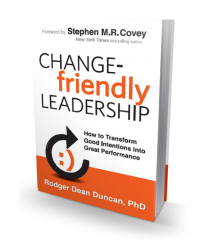Change Friendly Leadership by Dr. Rodger Dean Duncan
 When I got my review copy of Change Friendly Leadership, I was transported back to my college days of studying change management. It was a great course and I had a phenomenal teacher, so my thirst for ideas related to managing change well started early. Good thing I found this book! I have two pages of notes and I’m not even finished going back and digging into all of the pages I’ve flagged for further review. There may be another review in the future or even some posts on subtopics to delve deeper, because this thing is full of solid advice for business leaders trying to work within the change process.
When I got my review copy of Change Friendly Leadership, I was transported back to my college days of studying change management. It was a great course and I had a phenomenal teacher, so my thirst for ideas related to managing change well started early. Good thing I found this book! I have two pages of notes and I’m not even finished going back and digging into all of the pages I’ve flagged for further review. There may be another review in the future or even some posts on subtopics to delve deeper, because this thing is full of solid advice for business leaders trying to work within the change process.
Okay, now that I’ve built it up, let’s peel back the layers and dig into a few of the key points of Change-Friendly Leadership.
What I liked
- Training failure-The author quotes a study by ASTD (American Society for Training and Development) that says that despite record amounts being spent on training in the workplace, less than 30% of training is being implemented.
- Engagement in a nutshell–“A person is engaged when he feels positive emotions toward his work, when he regards his work as personally meaningful, when he considers his workload to be manageable, and when he has positive expectations (hope) about the future of his work.”
- Killer quote by Drucker–Results are obtained by exploiting opportunities, not by solving problems. This is another way of saying that you should play to your strengths, not focus exclusively on shoring up weaknesses.
- Trust in leadership is essential-According to a recent study by Towers Watson, only 47% of employees regard their leaders as trustworthy. (Pinnacle leadership scored in the upper 90s on this topic in an anonymous employee survey earlier this year. Woohoo!)
- Paper vs. people-Change implementations are easy on paper. Move some numbers. Make some calls. Then the hard part comes when you insert people into the mix. It’s critical to consider the “people impact” before you start planning a change initiative. Otherwise the poor planning could lead to further issues down the road.
- Compliance or commitment? Would you rather have compliance or commitment from your people? Compliant staff will do what you tell them, when you tell them to do it. Committed staff will do what needs to be done even when you’re not there to tell them to do it. I know which group of employees I’d rather have on my team.
- Heat and light-People will react a certain way when they feel the heat/pressure of a decision weighing on them. Often times that is purely reactionary, leading to further problems. The preferred way to get support is not to turn up the heat, but to help people see the light. Help them to see the vision/goal and how they play a part in making it a reality.
- Welcome resistance-Often we talk about resistance to change as a piece to avoid or deter. But what if we welcomed the resistance instead? I can attest to new ideas springing from a single person’s protest about a new tool or process. Let your people be your guinea pigs. Let them poke holes in your plan. It will help you to ensure that you are doing what is best for them and for the organization. Another key piece of that is allowing them to see that their input influenced the direction of the decision–it not only increases engagement but also helps to deter future complaints because they participated in the the implementation.
- The list-This book takes you through several key steps to implementing change-friendly leadership. I’ll list them here but you’ll need to check out the book if you want the full details.
- Validate the journey
- Scan for speed bumps
- Chart the course
- Build a coalition
- Ford the streams
- Stay on message
- Mind the gap
Again, Change-Friendly Leadership is pretty darn amazing. I am excited about implementing a few of these ideas in my own workplace, and I hope to do a few more posts to continue sharing what I’ve learned in this change management tool. Click here to get your copy.
Click here for other book reviews or to learn about how to build your own leadership reading list.